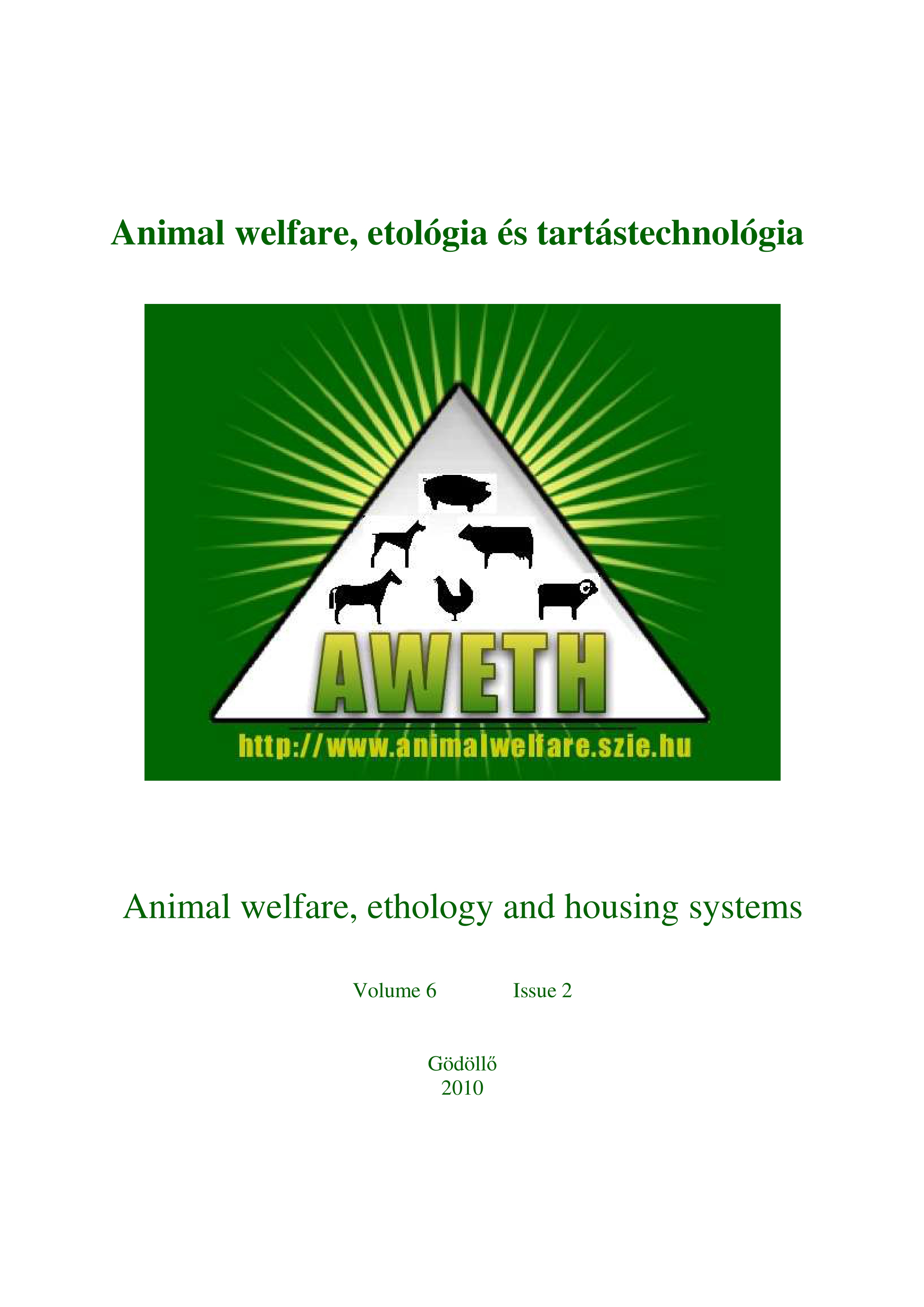Az RFID microchipek alkalmazhatósága a brojlercsirkék nyomonkövetésére
Kulcsszavak:
brojlercsirkék egyedjelölése, RFID microchip, naturális mutatókAbsztrakt
Az elvégzett brojlerhízlalási kísérlet célja az volt, hogy megállapítsák az állatok jelölésére használt RFID microchipek elvesztési arányát, leolvashatósági százalékát, továbbá a termelési paraméterekre gyakorolt hatását. A hízlalási kísérlet során két kezelést vizsgáltak (kontroll [jelöletlen] és kísérleti [RFID chippel jelölt]). A kísérletet a kontroll kezelésnél 8 (240 db csirke), míg a kísérleti kezelés esetében 6 (180 db csirke) ismétléssel végezték, ismétlésenként 30 db COBB genotípusú brojler kakassal. A kísérlet alatt a jelölt és a jelöletlen egyedek testsúlyában nem mutatkozott szignifikáns különbség (P > 0,05). Az alkalmazott RFID microchipes szárnyjelzőkre viszonylag magas elvesztés volt jellemző, ugyanakkor a kísérletbe bevont RFID microchipeket 98–99%-os leolvashatóság (R%) jellemezte, ami összevetve az irodalmi adatokkal rendkívül kedvező eredménynek számít. A kapott eredmények alapján megállapítható, hogy a szerzők által alkalmazott rádiófrekvencián alapuló egyedjelölési módszer alkalmas brojlercsirkék jelölésére és nyomon követésére, de a technológia gyakorlati elterjedéséhez szükséges a jelölés pontosságának és tartósságának növelése.
Hivatkozások
Applegate, R.D., Jamison, B.E., Robel, R.J., Kemp, K.E. (2000): Effect of passive integrated transponders on ring-necked pheasen chicks. T Kansas Acad Sci, 103(3–4) 150–156. https://doi.org/10.2307/3628263
Bauer, U., Kilian, M., Harms, J., Wendl, G. (2009): First results of a large field trial regarding electronic tagging of sheep in Germany. In: Lokhorst C.; Koerkamp P.W.G. (Ed) Precision livestock farming ’09. Wageningen Academic Publishers, Wageningen, 237–242. https://doi.org/10.3920/9789086866632_029
Caja, G., Conill, C., Nehring, R., Ribó, O. (1999): Development of a ceramic bolus for the permanent electronic identification of sheep, goat and cattle. Computers and Electronics in Agriculture, 24(1–2) 45–63. https://doi.org/10.1016/S0168-1699(99)00036-8
Carver, A.V., Burger, L.W., Brennan, L.A. (1999): Passive integrated transponders and patagial tag markers for northern bobwhite chicks. J Wildlife Manage, 63(1) 162–166. https://doi.org/10.2307/3802497
Curto, F.P.F., Nääs, I. de A., Pereira, D.F., Salgado, D.D’A., Murayama, M.C., Behrens, F.H. (2002): Predicting broiler breeder’s behavior using electronic identification. Agriculture Engineering International: the CIGR Journal of Scientific Research and Development. Manuscipt IT 02 001. Vol. IV. December
Dennis, R.L., Fahey, A.G., Cheng, H.W. (2008): Different effects of individual indentification systems on chicken well-being. Poultry Sci, 87(6) 1052–1057. https://doi.org/10.3382/ps.2007-00240
Elbin, S.B., Burger, J. (1994): Implantable microchips for individual identification in wild and captive populations. Wildlife Soc B, 22. 677–683.
Fröhlich, G., Thurner, S., Böck, S., Weinfurtner, R., Wendl, G. (2007): Radio frequency identification system for the recording of the behaviour of laying hens. Gesellschaft für Informatik in der Land-, Forst-, und Ernährungswirtschaft e. V. 1–9.
Füzesi I., Herdon M. (2005): RFID – rendszerek perspektívái a húsiparban. A HÚS, 4. 229–234.
Gere T. (szerk.) (2005): Gazdasági állatok viselkedése IV. A baromfi viselkedése. Szaktudás Kiadó Ház, Budapest, 37–41.
Gere T. , Csányi V. (szerk.) (2001): Gazdasági állatok viselkedése. Általános etológia. Mezőgazdasági Szaktudás Kiadó, Budapest, 206–207.
Hannon, S.J., Jönsson, I., Martin, K. (1990): Patagial tagging of juvenile willow ptarmigan. Wildlife Soc B, 18. 116–119.
Hogewerf, P.H., Schouten, W., Smits, A.C. (2005): Do hens really go outside if they are allowed to do so? In: Should hens be kept outside? Workshop of the Animal Science Group, UR Lelystad and the Dutch Ministry of Agriculture, Nature and Food. Wageningen, April, 18–20.
Hogewerf, P.H., Ipema, A.H., Binnendijk, G.P., Lambooij, E., Schuiling, H.J. (2009): Using injectable transponders for sheep identification. Joint International Agricultural Conference 65. Precison livestock farming. Wageningen, 6–8. July. https://doi.org/10.3920/9789086866632_031
Jackson, D.H., Bünger, W.H. (1993): Evaluation of passive integrated transponders as a marking technique for turkey poults. J Iowa Acad Sci, 100(2) 60–61.
Jamison, B.E., Beyer, R.S., Robel, R.J., Pontius, J.S. (2000): Passive integrated transponder tags as markers for chicks. Poultry Sci, 79(7) 946–948. https://doi.org/10.1093/ps/79.7.946
Kern, C. (1997): Technische Leistungsfähigkeit und Nutzung von injizierbaren Transpondern in der Rinderhaltung. Dissertation. TU München- Weihenstephan, 1997.
Kétszeri D. (2007): RFID (EPC) – A legújabb technológia az élelmiszerek nyomonkövetésére. Élelmiszervizsgálati közlemények, 80:1. 13–15.
Lambooij, E., van’t Klooster, C.E., Rossing, W., Smits, A.C., Pieterse, C. (1999): Electronic identification with passive transponders in veal calves. Computer and Electronics in Agriculture, 24(1–2) 81–90. https://doi.org/10.1016/S0168-1699(99)00038-1
Lambooy, E. (1990): Das Injizieren eines Transpnders in den Tierkörper zur Identification. In: Petersen, B., Welz, M. (Ed.), Beiträge zur Tagung EDV – Anwendung in der Herden- und Gesundheitskontrolle. Eugen Ulmer Verlag, Stuttgart,18–22.
Linderoth, S. (2005): How to assess individual animal ID technology: Five things to cheek before you buy. Dairy Herd Management, 32–37.
Low, M., Eason, D., McInnes, K. (2003): Evaluation of passive integrated transponder for identification of kakapo, Strigops habroptilus. Emu, 105(1) 33–38. https://doi.org/10.1071/MU04060
Marchant, J. (2002): Secure animal identification and source verification. Optibrand Ltd. LLC. Fort Collins, CO. 1–27.
Nehring, R., Caja, G., Ribó, O., Conill, C. , Solanes, D. (1998): Long-term performance of passive injectable transponders in sheep. J Anim Sci, 76. 267.
Pereira, D.F., Nääs, I. de A., Curto, F.P.F., Salgado, D., Murayama, M.C. (2003): Evaluating of the implanting sites microchip used in electronic identification in broiler breeders. Rev Bras de Agroinformática, 5(1) 13–23. https://doi.org/10.1016/j.compag.2007.09.001
Pereira, D.F., Nääs, I. de A. (2008): Estimating the thermoneutral zone for broiler breeders using behavioral analysis. Computers and Electronics in Agriculture, 62. 2–7.
Sahin, E., Dallery, Y., Gershwin, S. (2002): Performance evaluation of a traceability system. An application to the radio frequency identification technology. In: Proceedings of the 2002 IEEE International Conference on Systems, Man and Cybernetics. 3. 210–218. https://doi.org/10.1109/ICSMC.2002.1176118
Schuster, E. W., Allen, S.J., Brock, D.L. (szerk.) (2007): Agriculture: Animal Tracking. In: Global RFID. Springer-Verlag Berlin Heidelberg, Berlin, 119–126. https://doi.org/10.1007/978-3-540-35655-4_9
Smith, G.C. (1999a): Meeting the challenge…what can you do? Cattlemen’s College of the National Cattlemen’s Beef Association Midyear Conference. Denver, CO. 1–12.
Smith, G.C. (1999b): Providing assurances of quality, consistency, safety and a caring attitude to domestic and international consumers of US beef, prok, lamb. 12th World Meat Congress. Dublin, Ireland, 1–8.
Smith, G.C. (1999c): Traceability: Source-vertification, production practice-vertification and USDA process-vertification. Expo Prado ’99. Montevideo, Uruguay, 1–11.
Smith, G.C. (2004): Tracing US process on individual ID. Mimeograph Report. Meat & Livestock Journal, Nov/Dec Issue, 1–16.
Tóth L. (2008): RFID technológiára alapozott automatizálás az állattartásban. Animal welfare, etológia és tartástechnológia, 4:2. 51–59.
Watts, A.J., Miller, P.C.H., Godwin, R.J. (2003): Automatically recording sprayer inputs to improve traceability and control. In: Proceedings of the 2003 BCPC Congress Crop Science and Technology. UK: BCPC publicatons, Glasgow, 323–328.
Letöltések
Megjelent
Folyóirat szám
Rovat
License
Copyright (c) 2010 Tóth Ágnes, Hermán Anikó, Ásványi Molnár Noémi, Ásványi Balázs, Kreizinger Ferenc, Gabnai István, Turcsán Zsolt, Szigeti Jenő, Fébel Hedvig

This work is licensed under a Creative Commons Attribution-NonCommercial-NoDerivatives 4.0 International License.
A folyóirat a nyílt hozzáférés elvei szerint működik, cikkeire ugyanakkor a Creative Commons 4.0 standard licenc alábbi típusa vonatkozik: CC-BY-NC-ND-4.0. Ennek értelmében a mű szabadon másolható, terjeszthető, bemutatható és előadható, azonban nem használható fel kereskedelmi célokra (NC), továbbá nem módosítható és nem készíthető belőle átdolgozás, származékos mű (ND). A licenc alapján a szerző vagy a jogosult által meghatározott módon fel kell tüntetni a szerző nevét és a szerzői mű címét (BY).














